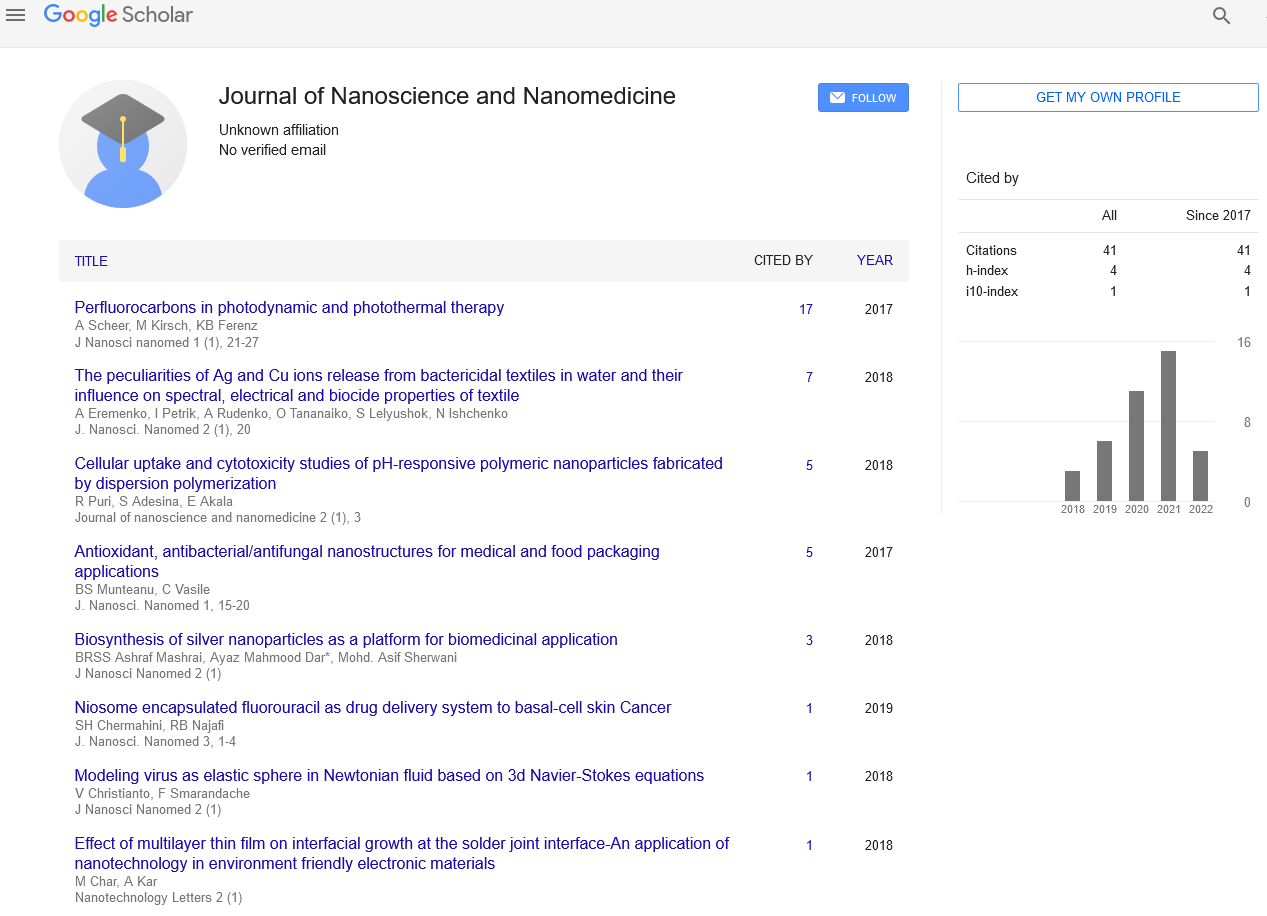Novel Properties of Zinc Sulfide Nanostructures
Received: 01-Jul-2021 Accepted Date: Jul 15, 2021; Published: 22-Jul-2021
Citation: Zhe Liu. Novel Properties of Zinc Sulfide Nanostructures. J Nanosci Nanomed 2021;5(4):1.
This open-access article is distributed under the terms of the Creative Commons Attribution Non-Commercial License (CC BY-NC) (http://creativecommons.org/licenses/by-nc/4.0/), which permits reuse, distribution and reproduction of the article, provided that the original work is properly cited and the reuse is restricted to noncommercial purposes. For commercial reuse, contact reprints@pulsus.com
Abstract
A Zinc sulfide (ZnS) nanostructures have pulled in expanding consideration due to their potential application in both conditional optical gadgets and modern era of nano-electronics and nano-optoelectronics since of their uncommon structure-related chemical and physical properties. In this article, starting with the blend of ZnS nanostructures with different unique morphologies, we summarize the state-of-art investigate advances on ZnS nanostructures. This is often taken after by the later advances on the advancement of their properties, particularly the novel potential applications. We highlight the later accomplishments on photoluminescence, photocatalysis, light-emitting diodes (LEDs), field-effect transistors (FET), sensors, dye-sensitized sun powered cells, and field emanation (FE) based on ZnS nanostructures. Finally, we show an viewpoint on end of the improvement of ZnS nanostructures.
Keywords
Zinc sulfide, Nanostructures, Nano-electronics, Photoluminescence.Introduction
Zinc sulfide (ZnS) is one of the primary semiconductors found. It has customarily appeared momentous flexibility and guarantee for novel crucial properties and assorted applications. The nanoscale morphologies of ZnS have been demonstrated to be one of the wealthiest among all inorganic semiconductors. In this article, we offer a comprehensive survey of the stateof-the-art inquire about exercises related to ZnS nanostructures. We start with a chronicled foundation of ZnS, depiction of its structure, chemical and electronic properties, and its unique points of interest in particular potential applications. This can be taken after by in-detail talks on the later advance within the union, examination of novel properties and potential applications, with the center on the basic tests deciding the electrical, chemical and physical parameters of the nanostructures, and the transaction between engineered conditions and nanoscale morphologies [1].
ZnS is the foremost critical base fabric for cathode-ray tube luminescent materials. Mechanically, ZnS union is performed by precipitation in an watery medium. Precipitation strategies included in this think about are homogeneous precipitation, precipitation in fluid gem stage and the presentation of seeds. Zinc sulfide (ZnS), a naturally occurring salt, is the most source of zinc. It has two common crystalline shapes (polymorphs): Sphalerite (“zinc blende”), with a cubic precious stone structure, is the frame that prevails in nature. Zinc sulfide shows up as a yellowish-white powder in a fluid. Insoluble in water and denser than water. At long last, we highlight the later accomplishments with respect to the advancement of ZnS novel properties and finding imminent applications, such as field emitters, field impact transistors (FETs), p-type conductors, catalyzators, UV-light sensors, chemical sensors (counting gas sensors), biosensors, and nanogenerators [2].
Generally this audit presents an orderly examination of the ‘synthesisproperty-application’ triangle for the differing ZnS nanostructures. It is commonly utilized as a white color. Locator of alpha-rays, which render it luminescent. Infrared optics. It is utilized as phosphor in a few applications, counting X-ray screens and cathode beam tubes. The chemical structure of ZnS is straightforward and comprises of the zinc metal connected to a sulfur molecule through a polar covalent bond. Strong zinc sulfide is found in two distinctive precious stone shapes, alpha (wurtzite) and beta (sphalerite), which have hexagonal and cubic structures, individually [3].
Conclusion
In conclusion, as one creating star of the semiconductor families, ZnS could be a flexible fabric with great optical and electrical properties, which are suit to numerous novel opticalelectrical gadgets. In this article, ZnS nanostructures synthesized by both the arrangement strategies (empty nanostructures, core/shell nanostructures, nano-urchins, and nanoflowers nanostructure clusters) and gas stage strategies (nanowires, nanobelts, nanotubes, nanoarrays, coaxial, homoepitaxial, and heteroepitaxial nanostructures) were surveyed comprehensively. In expansion, the novel properties and applications counting photoluminescence, photocatalysis, sensors, LEDs, FET, sun oriented cells, and field-emission of these nanostructured materials were moreover displayed. In spite of the fact that extraordinary advances within the development of ZnS nanostructures and their applications have been made in later a long time, a few vital challenges still stay and got to be investigated.
REFERENCES
- Ramamoorthy R, Kanagasabai V, Kausalya R. Impact of celebrities' image on brand. Int J Pure Appl Math. 2018;119(12):3625-3630.
- Zhu GX, Zhang SG, Xu Z et al. Ultrathin ZnS single crystal nanowires: Controlled synthesis and roomtemperature ferromagnetism properties. J Amer Chem Soc. 2011;133(39):15605–15612.
- J. Zhang JG, Yu Y, Zhang M et al. Visible light photocatalytic H2- production activity of CuS/ZnS Porous nanosheets based on photoinduced interfacial charge transfer. Nano Lett. 2011;11(11):4774– 4779.
- Fowler CF, Khushalani D, Mann S et al. Interfacial synthesis of hollow microspheres of mesostructured silica, Chem. Commun.2001;19(19):2028–2029.





